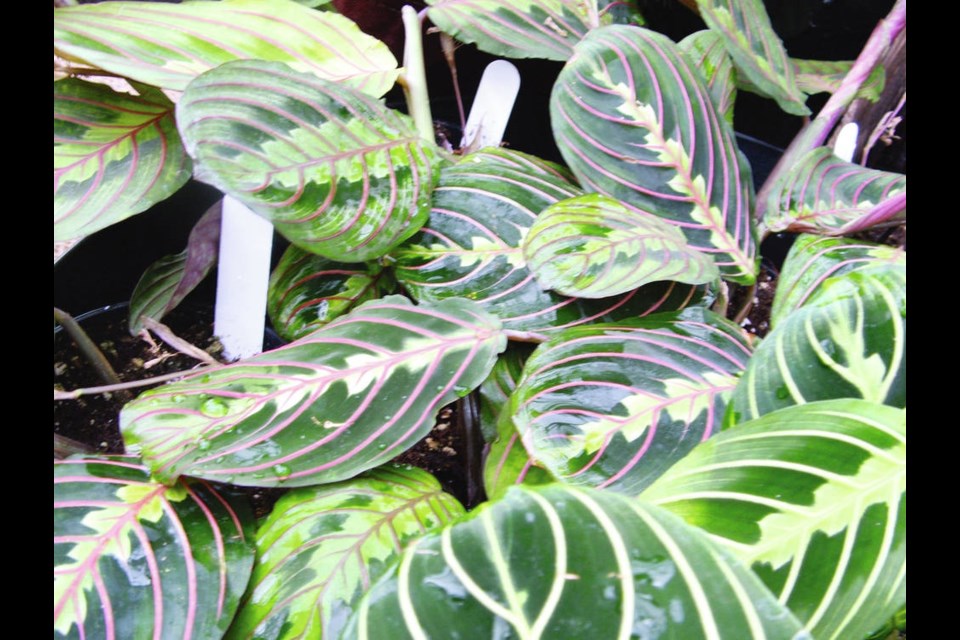Dear Helen: I am puzzled by a thrivinghouse plant I bought in the spring. The label identifies it as Calathea, and the description fits but its leaf behaviour does not. In the morning, the leaves are almost horizontal but by bed time they are almost vertical. Any comments on this puzzle? Is this a “prayer” plant?
C.N.
Calathea is a member of the Marantaceae family, whose two probably best known members are Maranta and Calathea. Both are known as “prayer plants” because, to varying degrees depending on the variety, they fold up and raise their leaves, as if to pray, at night.
These plants are native to rainforests, where they open their leaves during the day to soak up light. When there is no more light, they return to their folded position.
Marantas and Calatheas are similar in appearance. Both have ornamental foliage with coloured veining or blotches. Marantas are lower growing, with oval leaves marked with red or white “herringbone” patterning or with dark blotches. Most Calatheas have oval leaves too, with various brightly coloured patterns. Most forms are taller than the Marnatas and hold their leaves more upright.
A Calathea I saw recently in a garden centre had long, spear-shaped leaves with wavy margins and dark, symmetrical marks. It is commonly known as Rattlesnake Plant (Calathea insignis, C. lancifolia).
Calathea and Maranta plants have similar requirements, though the Calatheas are generally more difficult. General needs for both are an even, average room temperature with a minimum winter low of 15 C, bright but indirect light (no direct sun), high levels of humidity, and a moist soil with reduced water in winter.
Dear Helen: Of the bumper crop of apples on our espaliered trees this fall, about half were afflicted with what we think is the fungal disease called apple scab. The unsightly “scabs” were only on the skin and did not penetrate the flesh. Should the leaves under the tree be raked up to help prevent the spread of the fungus? What else can be done to minimize the presence of this disease next year?
P.S.
It is expedient to carefully rake up all the leaves that have fallen and remove any still clinging to the tree in the fall. the fungus over-winters on these old leaves, and springs to life again in the spring rains, which splash spores onto the tree to initiate another round of infection.
Because the spores germinate in wet weather, this year’s rather moist spring and early summer could explain the high incidence of scab on your apples. Wet conditions foster secondary, continuing infections.
When the scabs rest on the skin and the flesh is fine, the infection is considered light to moderate. A severe infection causes cracks to develop at the scarred sites
Bury the leaves deep in the soil, burn them where regulations allow it, or dispose of them. In the spring, watch for water-soaked spots on the undersides of new leaves. The spots gradually darken, and similar spots appear on the developing fruit. The spots become corky scabs.
Keep the espaliers pruned and thinned enough to ensure free circulation of air and full sunlight penetration to the foliage and fruit. You can’t stop the rain, but watering at ground level will help to keep the leaves as dry as possible. In late winter or early spring, mulch generously under and around the plants with a nourishing compost, purchased or home-made.
Dear Helen: I was smitten recently with a maidenhair fern in a garden centre display. I did not buy it, because I’d heard they were too difficult to keep alive in most homes.
P.L.
In my view, maidenhair is the most lovely of all ferns. It is also probably the most difficult in the conditions inside most homes. The delicacy of the leaves point to the maidenhair fern’s delicate constitution.
The plants require warmth, shade, and moist air. This makes them ideal for the humid atmosphere of a terrarium.
Dear Helen: Can all kinds of leaves be used as protective winter mulches over bare soil and around vulnerable plants like winter vegetables?
A.G.
Most deciduous leaves are fine. An exception is black walnut, whose leaves contain a growth-suppressing chemical The leaves are safe to use after composting, which breaks down the chemical.
I like the fluffy mulch that my neighbours’ small Japanese maple leaves make, but even large, coarse-textured leaves can be used. They just take longer to break down.



